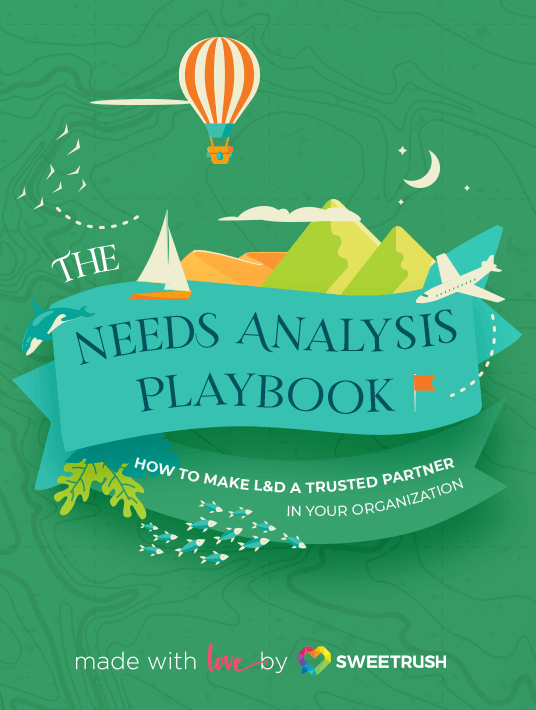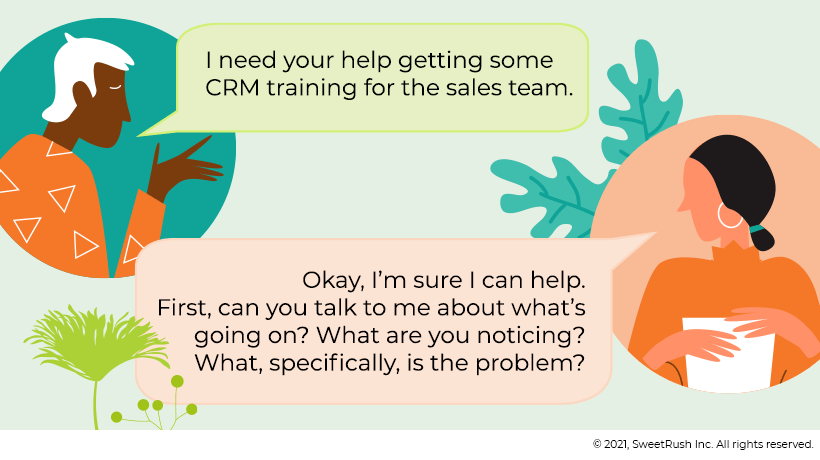Transform Stakeholders’ Wants Into Business Needs
Stakeholders aren’t learning professionals, so they tend to approach L&D with what they want—aka solutions—instead of what they need. But if you don’t know what the underlying problem is, how can you be sure that training will solve it?
A number of years ago, I worked with a client whose stakeholders wanted a new onboarding program (a solution). On the surface, it seemed like a simple enough request. Onboarding programs are designed to orient newcomers to the company’s mission and values, organization and structure, products and services, and such. Ultimately, these programs strive to make the new hire feel that they made a great choice by joining. But there was a twist...

The Needs Analysis Disconnect
When we started talking about desired outcomes (more on these later), the client mentioned things like reducing attrition rates and increasing engagement—metrics that are usually tied to the emotional, cultural, and social aspects of the job, such as having a sense of purpose, feeling valued, and having positive relationships with management and leadership.
Something didn’t add up.
I knew that an onboarding program wouldn’t solve the business needs as a stand-alone solution. So, I asked the client two simple questions:
- Do you know why people are leaving?
- What does your latest employee engagement survey say?
Sadly, the client either didn’t know or couldn’t tell us the answers. They just wanted the new onboarding program.
This response spoke volumes. It told me that the client:
- Didn’t fully understand the stakeholders’ needs or what was driving the business need
- Couldn’t see the disconnect between the underlying business need, the desired outcomes, and the solution
- Hadn’t considered how they would evaluate the success of the program
Most worryingly, it told me that the client was prepared to risk losing trust and credibility with the stakeholders by giving them what they wanted rather than what they needed.
What the stakeholder wants and what the stakeholder needs are often two very different things. As an L&D professional, your job is to help them see the difference. You can do this by consulting with them and asking questions to fully understand what they want, so that together, you can uncover what they need. As a bonus, you will build relationships, establish credibility, and gain each other’s trust throughout the process.
So, how do you consult with your stakeholders? What are the right questions to ask? And what do you need to know to steer the conversation and influence their decisions?
I’ve got you covered! I’ve compiled six questions that you should ask your stakeholders every time they come to you with a training request, to effectively (and quickly!) identify the business need.
Six Stakeholder Analysis Questions To Identify Business Needs And Inform Your Learning Solutions
Question 1. What is the training need? (What has driven this request?)
All training needs are either about advancing people’s knowledge and skills or about changing their behavior.
So how do you get your stakeholders to talk about knowledge, skills, and behaviors?
When your stakeholders come to you with solutions—and they will!—you’ll need to steer the conversation to focus on the underlying problem. Take a look at this example.

When you ask your stakeholders to describe what’s going on, they’ll be forced to respond in a way that addresses performance:

The information you have now is so much more revealing than what you started with. You now have a better sense of the specific problem and whom it’s affecting. It still doesn’t reveal the full picture, but you now have a jumping-off point to explore the need further with the stakeholder.
Question 2. What are the desired outcomes? (What does success look like?)
Desired outcomes are different from, but connected to, the learning objectives that will eventually steer your solution design.
Like learning objectives, desired outcomes should be observable or measurable. Where they differ is that learning objectives are typically linked to knowledge, skills, or behavior, whereas the desired outcomes are about business results and impact.

When you can clearly define the desired outcomes, you’ll have a greater chance of designing a solution that will add value and create impact to the business. And when you can do those things, you will gain the trust and credibility you deserve!
Question 3. Who is the target audience?
Knowing who the target audience is will help you prepare for the learner audience analysis. It will also help you determine whether you need to adapt your solution for different audiences.
If your target audience is limited to the members of one group or team, you’ll know that you can tailor the content and message specifically to them. If your stakeholder identifies more than one audience, however, you’ll need to ask whether there is a primary audience among that group and, if so, who the secondary and tertiary audiences are. This way, you can ensure that the needs of your primary audience are met first. You can then adapt the content to the other audiences afterward as needed
Question 4. What should they (the target audience) be doing?
This question is actually two questions in disguise. How? As soon as you ask, “What should they (the target audience) be doing?” I guarantee that your stakeholders won’t be able to resist also telling you what they are currently doing. And when you know the answer to both of those questions, you’ll have your performance gap. And when you know your performance gap, you can define the learning objectives. Bingo!
Question 5. How will we measure success?
Now that you know what the desired outcomes and performance gaps are, you can begin planning how you will measure success after you identify business needs.
Remember, you are still in the analysis phase, so all you have to determine right now is the evaluation strategy you are going to use. Assuming you’re using the Kirkpatrick Model [1], will it be Level 1, 2, 3, 4, or a combination?
This is the time to step up your consulting game. Use your expertise to inform, guide, and influence the stakeholder into choosing the most appropriate and robust strategy.

To help inform their decision, make sure you discuss the following:
- Evaluation options: Share examples of the types of activities you might design to measure at each level.
- Benefits of evaluating at each level: Reveal the insights and results that each level of evaluation will yield.
- Effort involved at each level: Call out what it might take to design, develop, and implement the activity or approach. Don’t forget to factor in what it will take to capture and analyze the results.
- Risks of not doing an evaluation: (This is the big one and helps influence the decision-making.) Emphasize the value of the evaluation strategy by calling out what might be at stake if you don’t measure results or impact.
Check out Chapter 1 of our new guide, The Needs Analysis Playbook for more tips and tools to help you with your evaluation conversation.
Question 6. What Might Enable or Derail the Success of the Solution?
The final stakeholder question relates to the application of the learning. As learning professionals, we spend most of our time thinking about success in terms of outcomes and impact—all the stakeholder analysis questions I have shared so far have been focused on just that. We sometimes forget, however, to think about factors outside of the solution that can enable or derail its success.
Interestingly, the things that enable success can also be barriers.
Internal enablers and barriers are the factors within the learner’s control that can determine whether the learner is willing to apply the learning, such as: their mindsets, attitudes, and beliefs.

Changing people’s attitudes isn’t easy. You can, however, shift mindsets, and you can acknowledge and influence people’s beliefs. You just need to know what they are, first.
External enablers and barriers are the factors outside of the learners control that can determine whether the learner is able to apply the learning such as: policies and procedures, systems and tools, culture, and people.

When any of these act as barriers, you’ll need to address them with your stakeholders and explore removing them or working around them.
Identify The Business Need—And Determine If Training Will Meet The Need
Think of the answers to these six questions as your North Star. The knowledge and insights you capture here will steer everything that follows—not only in the rest of the needs analysis itself but also throughout the process of designing, developing, implementing, and evaluating your learning solution.
The stakeholder analysis tells you:
- What has driven the business need—and what the problem is that you are trying to solve
- What the desired outcomes are—and what success looks like
- Who the target audience is—and whether you need to consider other audiences’ needs, either now or later in the process
- What the performance gaps are—and what your learning objectives should be
- Which evaluation strategy you need to implement—and how you will measure success
Above all, the stakeholder analysis will give you the answer to the $10 million question: Will training solve the problem? And what, if anything, will you need to ensure success (business champions, change management strategies, updates to policies or procedures, mindset shifts, etc.)?
Use these six questions to kick off your needs analysis, identify the business need, and begin to build trust with your stakeholder.
Conclusion
Need more help with your needs analysis? Check out our eBook, The Needs Analysis Playbook: How to Make L&D a Trusted Partner in Your Organization, for a detailed walkthrough of the process. Packed with advice, tips and tricks, and step-by-step instructions, we reveal how you can elevate your learning solution designs and gain that all-important stakeholder buy-in.
References:
[1] https://www.kirkpatrickpartners.com/Our-Philosophy/The-Kirkpatrick-Model.










